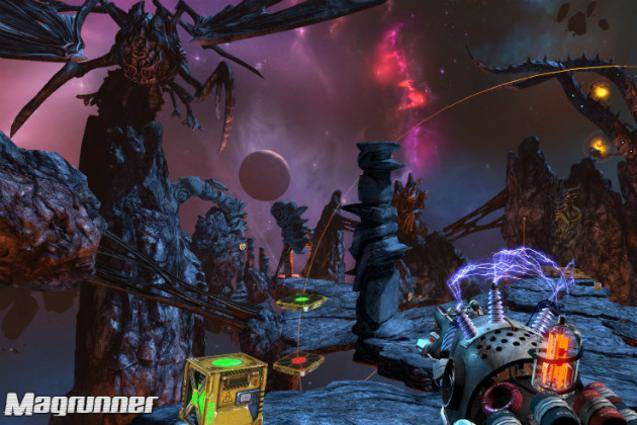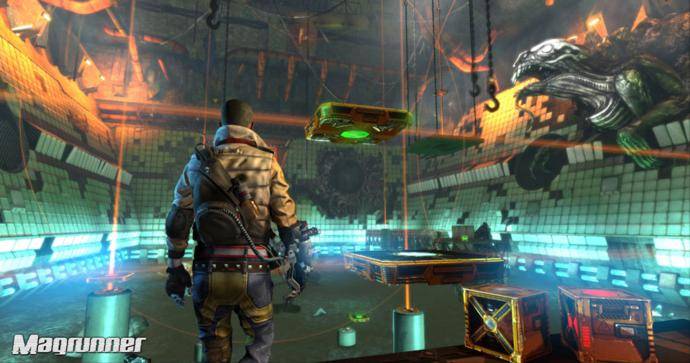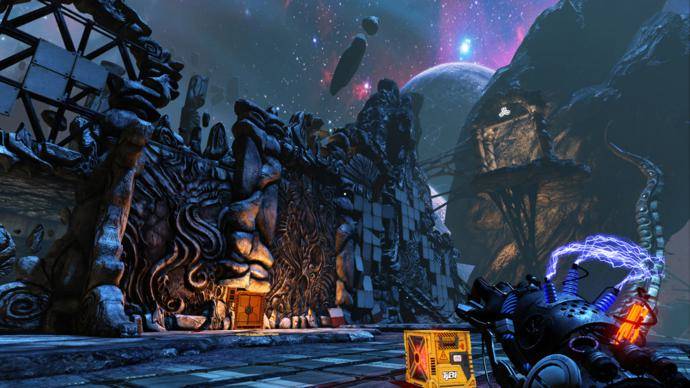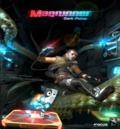Magrunner: Dark Pulse Review
Introduction
Taking cues from Portal, 3AM Games’ debut title is one of the many physics-based puzzlers that have been emerging as of late. Initially conceived on Kickstarter, Magrunner: Dark Pulse uses magnetism as its core game mechanic and has a heavy focus on narrative. Regrettably, this ambitious project is held back by some pesky flaws.
Literary Inspiration
Magrunner takes place in the year 2050 in a cyberpunk setting where the world is run mostly by big business. One of these companies, the Gruckezber Corporation, specializes in space exploration, and they have brought together seven gifted individuals to run through their Magtech training facility.
One of the seven is Dax Ward, an orphan child prodigy raised by his trainer Gamaji. Dax – and presumably the other candidates – is equipped with a Magtech glove that’s able to shoot magnetic charges into certain objects in order to solve the facility’s puzzles found in its numerous rooms.
Things start out normal, but then quickly turn weird after the first few levels. Power outages start happening, communication with Gamaji and the people in charge becomes clunky, and weird chants can be heard through the PA system. A man is murdered by a strange fish creature, and spooky writing on walls mention a being known as “Cthulu.” That’s right, this sci-fi puzzler just went Lovecraft.




The story, as silly as it is, is presented rather well and is actually quite engaging as it unravels. Cthulu’s evil gradually takes over the test chambers, the music becomes more ominous, and soon enough the facility starts crumbling. Dax becomes trapped, and the only way he can move on is by going deeper into the facility, which grows more macabre with every room.
The Unreal engine was used to great effect here, with the textures becoming grittier and the lighting and shadows being used to give a grimmer atmosphere. These aesthetics work well together, but where Magrunner begins to stumble is with its gameplay.
Lofty Goals
Real-world magnetism is a pretty basic concept: different poles attract one another, and identical poles repel. In Magrunner the opposite is true. Whether this was by design or an oversight is unclear, but it does seem a bit odd. Regardless, this concept does make for some interesting puzzles, and is easy enough that most will get the hang of it quick.
Sure enough, the developers used the simplicity of magnetism to their advantage. There’s little to no guidance given to demonstrate just how the mag glove works on cubes and platforms. Instead, the early levels have these objects placed in such a way that makes figuring out what to do with them obvious.
A typical setup is a few square platforms that move on beams of light, and a small cube or two. All of these items need to be manipulated using the mag glove’s green and red polarity beams in order to change their magnetic fields, thereby allowing them to interact with each other.
The cubes are either used for activating pads so the mag glove can change their polarity, or placed on special pads that propel them, and the player, to a different platform or an exit. This typically requires changing the polarities of the platforms in the room, so Dax can ride them to different areas, or use them to pick up cubes that he can’t reach.
Soon, buttons and cubes with other properties start appearing as the puzzles become more complex. The platforms start requiring more intricate uses of the mag glove, and the player at times is constantly changing their polarities in order to move them in the right direction.
Mixed Results
It’s at this point that sloppy design starts to seep in. While these later puzzles can certainly be head-scratchers, some start losing the craft they had earlier. Navigating the platforms to reach other areas, and even catch cubes with their magnetic fields, becomes repetitive. A lengthy sewer maze level is one of the biggest culprits, with its long corridors and slow platforms making it a dull experience.
To add insult to injury, the game begins to lose rhythm by slipping in some elementary puzzles after a string of challenging rooms, and some of the solutions are less satisfying. This is particularly a problem in chambers where the solution is clear, like moving a cube to a pad that’s currently unreachable, but getting to that point is an arduous process.
There is some good here, though. A lot of puzzles payoff well and are designed effectively, and the writing is engaging enough to make trudging through the mucky parts at least tolerable.
The game really is at its best during the beginning levels and the final act. The story picks up, the set pieces are much more realized, and the nice art direction is on full display. The puzzles are cleverer, as well, and some are almost awe inspiring.
Conclusion
Magrunner contains some great ideas, and has a lot of good qualities. There are plenty of stages to explore, a solid mechanic, a serviceable story, slick visuals and a nice soundtrack. Unfortunately, it doesn’t quite follow through with its aspirations. There are too many puzzles that either feel slapped together or are more tedious than fun, and some feel out of place completely. The game is at least moderately enjoyable, though, despite the fact it’s very rough around the edges.

